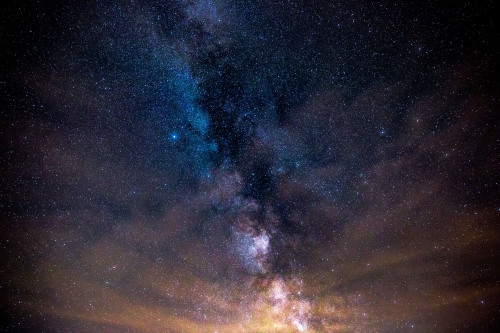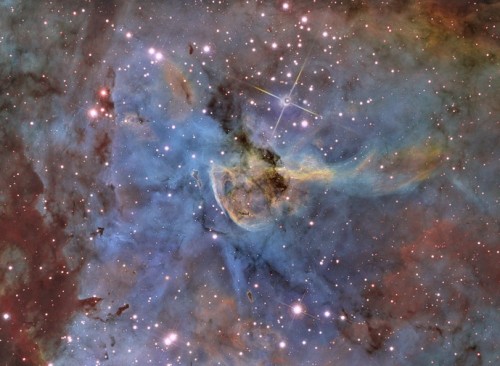Orion Nebula And Horsehead Nebula

Orion Nebula And Horsehead Nebula
More Posts from Littlecadet-biguniverse and Others

Solar surges are cool jets of plasma ejected in the solar atmosphere from chromospheric into coronal heights. This particular surge has been captured in a loopy structure and streamed sunwards along the magnetic field lines.
Surges are associated with active regions and they are most likely triggered by magnetic reconnection and magnetohydrodynamic (MHD) wave activity. According to their morphological features, surge prominences can be classified into three types: jet-like, diffuse, and closed loop (above). Jet-like and diffuse surges are associated with coronal mass ejections (CMEs), but the closed-loop surges are not because the initial acceleration of the eruption is slowed down and finally stopped by the overlying coronal loops.
Credit: SDO/ LMSAL

Milky Way js

Crab Pulsar at the core of the Crab Nebula

Crescent Nebula

Galaxy Ngc474
What is the difference between a supernova and a hypernova?
That’s a really good question, and the simple answer is that a hypernova produces way more energy than a standard supernova. Supernovae are known as being bright explosions from massive stars, and their remnant is usually a neutron star.

Hypernovae, however, more commonly produce black holes due to being from stars more massive than those that cause supernovae. Often time, they appear brighter too, which is why an alternate name for hypernovae is “superluminous supernovae”. Hypernovae are sometimes also the cause of gamma-ray bursts, a dangerous release of energy so high that it will fry anything in its path.

Thanks for asking! :)

Eta Carinae and Keyhole Nebula (NGC 3324), inside the Carina Nebula (NGC 3372)

Milky Way js

This beautiful supernova remnant is the product of a huge stellar explosion in our neighboring galaxy — the Small Magellanic Cloud (📷 : NASA)
-
 hizuno liked this · 8 years ago
hizuno liked this · 8 years ago -
 synthwave-unicorn reblogged this · 8 years ago
synthwave-unicorn reblogged this · 8 years ago -
 weregoingsurfinonthejellone-blog liked this · 8 years ago
weregoingsurfinonthejellone-blog liked this · 8 years ago -
 dontbelieveinmodernlove reblogged this · 8 years ago
dontbelieveinmodernlove reblogged this · 8 years ago -
 dontbelieveinmodernlove liked this · 8 years ago
dontbelieveinmodernlove liked this · 8 years ago -
 littlecadet-biguniverse reblogged this · 8 years ago
littlecadet-biguniverse reblogged this · 8 years ago -
 ostentatiousrrex liked this · 8 years ago
ostentatiousrrex liked this · 8 years ago -
 nebelung-dragon liked this · 8 years ago
nebelung-dragon liked this · 8 years ago -
 synthwave-unicorn reblogged this · 8 years ago
synthwave-unicorn reblogged this · 8 years ago -
 fallenpotential-blog liked this · 8 years ago
fallenpotential-blog liked this · 8 years ago -
 musictomytradegy-blog liked this · 8 years ago
musictomytradegy-blog liked this · 8 years ago -
 caspercorvus liked this · 8 years ago
caspercorvus liked this · 8 years ago -
 nervousstrangersandwich liked this · 9 years ago
nervousstrangersandwich liked this · 9 years ago -
 whencassiopeaexploded-blog reblogged this · 9 years ago
whencassiopeaexploded-blog reblogged this · 9 years ago -
 anameiktos liked this · 9 years ago
anameiktos liked this · 9 years ago -
 490531168 liked this · 9 years ago
490531168 liked this · 9 years ago -
 eyes-to-the-skies liked this · 9 years ago
eyes-to-the-skies liked this · 9 years ago -
 ancyd liked this · 9 years ago
ancyd liked this · 9 years ago -
 monstercake00 reblogged this · 9 years ago
monstercake00 reblogged this · 9 years ago -
 straightouttacomptongamma-blog reblogged this · 9 years ago
straightouttacomptongamma-blog reblogged this · 9 years ago -
 invaderrife reblogged this · 9 years ago
invaderrife reblogged this · 9 years ago -
 theechocolategoddess-blog reblogged this · 9 years ago
theechocolategoddess-blog reblogged this · 9 years ago -
 demonicssss-blog reblogged this · 9 years ago
demonicssss-blog reblogged this · 9 years ago -
 demonicssss-blog liked this · 9 years ago
demonicssss-blog liked this · 9 years ago -
 purplequeenh reblogged this · 9 years ago
purplequeenh reblogged this · 9 years ago -
 purplequeenh liked this · 9 years ago
purplequeenh liked this · 9 years ago -
 gravitationalbeauty-official reblogged this · 9 years ago
gravitationalbeauty-official reblogged this · 9 years ago -
 full-out-nerd reblogged this · 9 years ago
full-out-nerd reblogged this · 9 years ago -
 grandnightsong reblogged this · 9 years ago
grandnightsong reblogged this · 9 years ago -
 grandnightsong liked this · 9 years ago
grandnightsong liked this · 9 years ago -
 whoami1130 reblogged this · 10 years ago
whoami1130 reblogged this · 10 years ago -
 uss-gumdrop reblogged this · 10 years ago
uss-gumdrop reblogged this · 10 years ago -
 thatfrumpyfangirl reblogged this · 10 years ago
thatfrumpyfangirl reblogged this · 10 years ago -
 thatfrumpyfangirl liked this · 10 years ago
thatfrumpyfangirl liked this · 10 years ago -
 foundinthegrass liked this · 10 years ago
foundinthegrass liked this · 10 years ago
GREETINGS FROM EARTH! Welcome to my space blog! Let's explore the stars together!!!
144 posts
